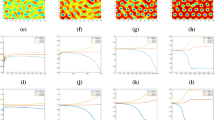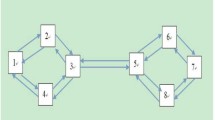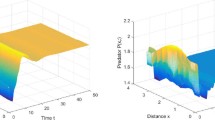Abstract
Predator–prey model with modified Leslie–Gower and Holling type III schemes governed by reaction–diffusion equations can exhibit diversified pattern formations. Considering that species are usually organized as networks instead of being continuously distributed in space, it is essential to study predator–prey system on complex networks. There are the close relation to discrete predator–prey system and continuous version. Here, we extend predator–prey system from continuous media to random networks via finite volume method. With the help of linear stability analysis, Turing patterns of the Leslie–Gower Holling type III predator–prey model on several different networks are investigated. By contrasting and analyzing numerical simulations, we study the influences of network type, average degree as well as diffusion rate on pattern formations.






Similar content being viewed by others
References
Ghosh, P.: Control of the Hopf–Turing transition by time-delayed global feedback in a reaction–diffusion system. Phys. Rev. E 84, 016222 (2011)
Ghorai, S., Poria, S.: Pattern formation in a system involving prey–predation, competition and commensalism. Nonlinear Dyn. 89, 1309–1326 (2017)
Sun, G.Q.: Pattern formation of an epidemic model with diffusion. Nonlinear Dyn. 69, 1097–1104 (2012)
Rostami, Z., Jafari, S., Perc, M., Slavinec, M.: Elimination of spiral waves in excitable media by magnetic induction. Nonlinear Dyn. 94, 679–692 (2018)
Murray, J.D.: Mathematical Biology II: Spatial Models and Biomedical Applications, 3rd edn. Springer, Berlin (2003)
Brauer, F., Castillo-Chavez, C.: Mathematical Models in Population Biology and Epidemiology, 2nd edn. Springer, Berlin (2012)
Turing, A.M.: The chemical basis of morphogenesis. Philos. Trans. R. Soc. Lond. B Biol. Sci. 237, 37–72 (1952)
Kondo, S., Miura, T.: Reaction–diffusion model as a framework for understanding biological pattern formation. Science 329, 1616–1620 (2010)
Sun, G.Q., Jusup, M., Jin, Z., Wang, Y., Wang, Z.: Pattern transitions in spatial epidemics: mechanisms and emergent properties. Phys. Life Rev. 19, 43–73 (2016)
Malchow, H., Petrovskii, S.V., Venturino, E.: Spatiotemporal Patterns in Ecology and Epidemiology: Theory, Models, and Simulations. Chapman & Hall/CRC Press, London (2008)
Levin, S., Segel, L.: Hypothesis for origin of planktonic patchiness. Nature 259, 659 (1976)
Sengupta, A., Kruppa, T., Lowen, H.: Chemotactic predator–prey dynamics. Phys. Rev. E 83, 031914 (2011)
Lai, Y.M., Newby, J., Bressloff, P.C.: Effects of demographic noise on the synchronization of a metapopulation in a fluctuating environment. Phys. Rev. Lett. 107, 118102 (2011)
Zhang, X.C., Sun, G.Q., Jin, Z.: Spatial dynamics in a predator–prey model with Beddington–Deangelis functional response. Phys. Rev. E 85, 021924 (2012)
Choudhury, B.S., Nasipuri, B.: Self-organized spatial patterns due to diffusion in a Holling–Tanner predator–prey model. Comput. Appl. Math. 34, 177–195 (2015)
Giricheva, E.: Spatiotemporal dynamics of an NPZ model with prey–taxis and intratrophic predation. Nonlinear Dyn. 95, 875–892 (2019)
Jansen, V.A.A., Lloyd, A.L.: Local stability analysis of spatially homogeneous solutions of multi-patch systems. J. Math. Biol. 41, 232–252 (2000)
Nakao, H., Mikhailov, A.S.: Turing patterns in network-organized activator–inhibitor systems. Nat. Phys. 6, 544–550 (2010)
Fernandes, L.D., de Aguiar, M.A.M.: Turing patterns and apparent competition in predator–prey food webs on networks. Phys. Rev. E 86, 056203 (2012)
Asllani, M., Challenger, J.D., Pavone, F.S., Sacconi, L., Fanelli, D.: The theory of pattern formation on directed networks. Nat. Commun. 5, 4517 (2014)
Asllani, M., Busiello, D.M., Carletti, T., Fanelli, D., Planchon, G.: Turing patterns in multiplex networks. Phys. Rev. E 90, 042814 (2014)
Asllani, M., Carletti, T., Fanelli, D.: Tune the topology to create or destroy patterns. Eur. Phys. J. B 89, 260 (2016)
Petit, J., Lauwens, B., Fanelli, D., Carletti, T.: Theory of Turing patterns on time varying networks. Phys. Rev. Lett. 119, 148301 (2017)
Mimar, S., Juane, M.M., Park, J., Muñuzuri, A.P., Ghoshal, G.: Turing patterns mediated by network topology in homogeneous active systems. Phys. Rev. E 99, 062303 (2019)
Chang, L.L., Liu, C., Sun, G.Q., Wang, Z., Jin, Z.: Delay-induced patterns in a predator–prey model on complex networks with diffusion. New J. Phys. 21, 073035 (2019)
Wang, C.X., Chang, L.L., Liu, H.F.: Spatial patterns of a predator–prey system of Leslie type with time delay. PLoS ONE 11, e0150503 (2016)
Nindjina, A.F., Aziz-Alaouib, M.A., Cadivelb, M.: Analysis of a predator–prey model with modified Leslie–Gower and Holling-type II schemes with time delay. Nonlinear Anal. RWA 7, 1104–1118 (2006)
Acknowledgements
This study was funded by the National Natural Science Foundation of China (grant numbers 31700393, 11701348), the China Postdoctoral Science Foundation (project 2018T111091) and Key Area R&D Program of Shannxi Province (No. 2019ZDLGY17-07).
Author information
Authors and Affiliations
Corresponding author
Ethics declarations
Conflict of interest
The authors declare that they have no conflict of interest.
Additional information
Publisher's Note
Springer Nature remains neutral with regard to jurisdictional claims in published maps and institutional affiliations.
Rights and permissions
About this article
Cite this article
Liu, C., Chang, L., Huang, Y. et al. Turing patterns in a predator–prey model on complex networks. Nonlinear Dyn 99, 3313–3322 (2020). https://doi.org/10.1007/s11071-019-05460-1
Received:
Accepted:
Published:
Issue Date:
DOI: https://doi.org/10.1007/s11071-019-05460-1




